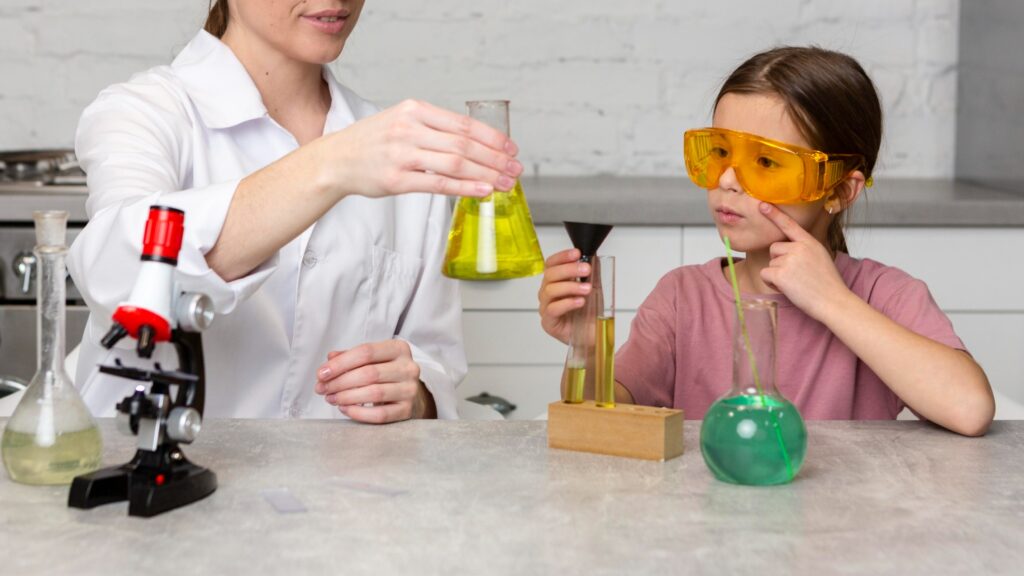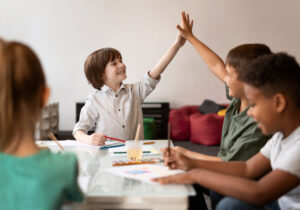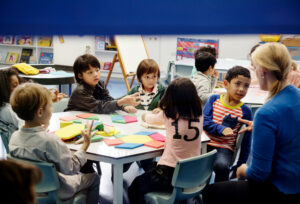Science fairs provide an exciting platform for students to engage with science beyond the classroom. Through hands-on experiments, students can explore fundamental scientific concepts, enhance their understanding, and develop valuable skills such as critical thinking, problem-solving, and communication. The following list outlines ten simple yet fascinating science experiments that are perfect for school science fairs. Each experiment includes a comprehensive explanation of the scientific principle behind it, detailed instructions, and insights into what students can learn from each activity. Let’s dive into the captivating world of science!
1. Volcano Eruption with Baking Soda and Vinegar
Concept: Chemical Reaction (Acid-Base Reaction)
Materials Needed:
- Baking soda
- Vinegar
- Dish soap
- Food coloring
- Small plastic bottle
- Clay or playdough for shaping the volcano
Instructions:
- Create the Volcano Structure: Use the clay or playdough to shape a volcano around the small plastic bottle, ensuring that the bottle’s opening is clear at the top.
- Prepare the Eruption: Inside the bottle, add a few drops of dish soap to create foam and a few drops of food coloring to give the “lava” an exciting color.
- Add the Baking Soda: Pour in 2 tablespoons of baking soda into the bottle.
- Erupt!: Quickly pour in vinegar and step back to watch the eruption unfold.
Explanation:
This experiment showcases an acid-base reaction. Baking soda, a base, reacts with vinegar, an acid, producing carbon dioxide gas. This gas builds up pressure, resulting in a foamy eruption that mimics a volcanic explosion. The combination of ingredients not only produces a visually stunning display but also emphasizes the principles of chemical reactions and gas production.
Educational Insight:
Students learn about the properties of acids and bases, how gases are produced during chemical reactions, and the concept of chemical changes. This experiment also allows students to engage with safety practices in handling chemicals, even in a non-toxic manner.
2. Rainbow in a Glass
Concept: Density
Materials Needed:
- Sugar
- Water
- Food coloring
- Clear glass
- Spoon
Instructions:
- Prepare Sugar Solutions: Create four different sugar-water solutions with increasing sugar concentrations (e.g., 1 tablespoon, 2 tablespoons, 3 tablespoons, and 4 tablespoons of sugar dissolved in equal amounts of water).
- Color Each Solution: Use different food colors to color each solution distinctly.
- Layer the Solutions: Slowly pour the most concentrated solution into a clear glass. Then, gently layer the next most concentrated solution on top without mixing. Repeat until all solutions are layered to form a rainbow effect.
Explanation:
The concept of density is key in this experiment. The sugar concentration affects the density of each solution. The denser solutions remain at the bottom, while the lighter solutions float above, demonstrating how liquids can layer based on density.
Educational Insight:
Students gain a practical understanding of density and solubility while also observing how different substances interact without mixing. This experiment can lead to discussions about real-world applications of density, such as in oil spills or layering in the ocean.
3. Growing Crystals with Salt or Sugar
Concept: Crystallization
Materials Needed:
- Table salt or sugar
- Hot water
- Jar
- String
- Pencil
Instructions:
- Create a Saturated Solution: Heat water until it is warm (ensure adult supervision). Gradually stir in salt or sugar until it dissolves completely, forming a saturated solution.
- Set Up the Jar: Tie a string around a pencil and balance the pencil on the top of the jar, allowing the string to dangle into the solution.
- Wait for Crystals: Place the jar in a quiet location and allow it to sit undisturbed for a few days. Observe the string for crystal formation.
Explanation:
As the water in the jar evaporates, the dissolved salt or sugar begins to crystallize on the string. This process highlights the phenomenon of crystallization, where particles organize into structured forms.
Educational Insight:
Through this experiment, students learn about the processes of evaporation and crystallization, as well as the differences between saturated and unsaturated solutions. This could lead to further exploration of crystal structures in nature, such as snowflakes and gemstones.
4. Lemon Battery
Concept: Electrical Conductivity
Materials Needed:
- Lemon
- Copper coin
- Zinc nail
- LED light or small bulb
- Wires with alligator clips
Instructions:
- Prepare the Lemon: Insert a copper coin and a zinc nail into the lemon, ensuring they do not touch each other.
- Connect to the LED: Use alligator clips to connect the zinc nail and copper coin to the LED light or bulb.
- Increase Power: For a brighter light, connect additional lemons in series.
Explanation:
The acidic juice in the lemon serves as an electrolyte, facilitating the flow of electrons between the zinc and copper, generating a small amount of electricity that powers the LED.
Educational Insight:Students learn about basic electrical concepts, including circuits and conductivity. This experiment introduces them to alternative energy sources and how chemical
reactions can be harnessed to produce electricity, fostering discussions about renewable energy and innovations in energy production.
5. Dancing Raisins
Concept: Carbonation and Buoyancy
Materials Needed:
- Clear carbonated soda (like Sprite or 7-Up)
- Raisins
- Clear glass
Instructions:
- Fill the Glass: Pour carbonated soda into a clear glass.
- Add the Raisins: Drop a few raisins into the soda and observe what happens.
Explanation:
The bubbles of carbon dioxide in the soda adhere to the surface of the raisins, causing them to rise to the top. When the bubbles pop, the raisins sink back down, creating a “dancing” effect.
Educational Insight:
This experiment provides a visual representation of buoyancy and gas dynamics. Students can explore concepts such as density, buoyancy, and the behavior of gases, enhancing their understanding of the properties of liquids and solids.
6. Magic Milk Experiment
Concept: Surface Tension and Chemical Reaction
Materials Needed:
- Milk
- Dish soap
- Cotton swab
- Food coloring
- Shallow dish
Instructions:
- Pour Milk: Fill a shallow dish with milk to cover the bottom.
- Add Colors: Drop different food colors around the surface of the milk.
- Add Soap: Dip a cotton swab in dish soap and touch it to the surface of the milk.
Explanation:
The dish soap reduces the surface tension of the milk, causing the food coloring to swirl and mix in vibrant patterns due to the soap’s reaction with the fat in the milk.
Educational Insight:
Students learn about surface tension, chemical reactions, and the properties of liquids. This experiment can spark discussions on the role of surfactants in everyday products, such as detergents and emulsifiers in food.
7. Invisible Ink with Lemon Juice
Concept: Oxidation
Materials Needed:
- Lemon juice
- White paper
- Cotton swab
- Heat source (like a lamp or iron)
Instructions:
- Write a Message: Use a cotton swab dipped in lemon juice to write a secret message on white paper.
- Dry the Paper: Allow the paper to dry completely.
- Reveal the Message: Carefully hold the paper close to a heat source to reveal the hidden message.
Explanation:
When heated, the lemon juice oxidizes and turns brown, revealing the message. This demonstrates a chemical change that occurs with heat exposure.
Educational Insight:
Students explore the principles of oxidation and heat reactions. This experiment can lead to discussions on other forms of invisible ink, such as those used in spy stories or security measures in various industries.
8. Balloon Rocket
Concept: Newton’s Third Law of Motion
Materials Needed:
- Balloon
- String
- Straw
- Tape
Instructions:
- Set Up the String: Thread a string through a straw and tie it between two points (like chair legs) so that it is taut.
- Prepare the Balloon: Inflate a balloon without tying it and tape it to the straw.
- Release the Balloon: Let go of the balloon and watch it propel along the string.
Explanation:
According to Newton’s Third Law of Motion, for every action, there is an equal and opposite reaction. The air rushing out of the balloon in one direction causes the balloon to move in the opposite direction.
Educational Insight:
Students learn about fundamental physics principles, particularly motion and forces. This experiment can be expanded to discuss real-life applications of rocket science and the basic principles that govern space travel.
9. Color-Changing Cabbage
Concept: pH Indicator
Materials Needed:
- Red cabbage
- Hot water
- Jars
- Household items (like vinegar, baking soda, and lemon juice)
Instructions:
- Make Cabbage Juice: Chop red cabbage and steep it in hot water to extract a purple cabbage “juice.”
- Distribute into Jars: Pour the cabbage juice into several jars.
- Test pH Levels: Add different household items (like vinegar, baking soda, or lemon juice) to each jar and observe the color changes.
Explanation:
Red cabbage juice contains anthocyanins, which act as natural pH indicators. The juice changes color when it interacts with acidic or basic substances, providing a visual demonstration of pH levels.
Educational Insight:
This experiment teaches students about acids, bases, and the concept of pH. It encourages exploration of natural indicators in everyday life and can lead to discussions about food chemistry and environmental science.
10. Paper Towel Water Absorption Race
Concept: Absorbency
Materials Needed:
- Different types of paper towels
- Water
- Stopwatch
Instructions:
- Prepare Bowls: Pour equal amounts of water into several bowls.
- Test Absorbency: Dip a different type of paper towel into each bowl, timing how long it takes for each towel to absorb the water completely.
- Compare Results: Analyze which paper towel absorbed the most water the fastest.
Explanation:
This experiment investigates the absorbent properties of various paper towels. Factors such as material composition and thickness influence how quickly and efficiently the towels can absorb liquid.
Educational Insight:
Students learn about material properties, absorbency, and how different materials interact with liquids. This experiment can extend to discussions on environmental sustainability and the importance of absorbent materials in various applications.
Conclusion
Engaging in these simple science experiments not only sparks curiosity but also fosters a deeper understanding of scientific principles in a fun and interactive way. Students will have the opportunity to explore essential concepts such as chemical reactions, density, buoyancy, electrical conductivity, and the scientific method through hands-on activities. Participating in a science fair can be a rewarding experience that encourages creativity and fosters a deeper appreciation for the scientific method. With these ten experiments, students are well-equipped to embark on their scientific journey, ready to explore, learn, and most importantly, have fun!
FAQs
Choose an experiment that interests you and matches your grade level. Consider the materials you have available and select an experiment you feel confident explaining. If you enjoy topics like chemistry, try experiments with chemical reactions; if you like physics, consider something like the balloon rocket.
Start by explaining the purpose of your experiment and the scientific concept it demonstrates. Describe the materials and steps involved, then discuss what happened and why. Make sure to explain any scientific terms in simple language. A poster with visuals and key points can also help make your presentation clear.
Add unique touches like colorful visuals, a clear explanation of the science behind the experiment, and any personal observations or discoveries you made while conducting it. Engaging the audience with questions or demonstrating a part of the experiment live can also make your project memorable.







